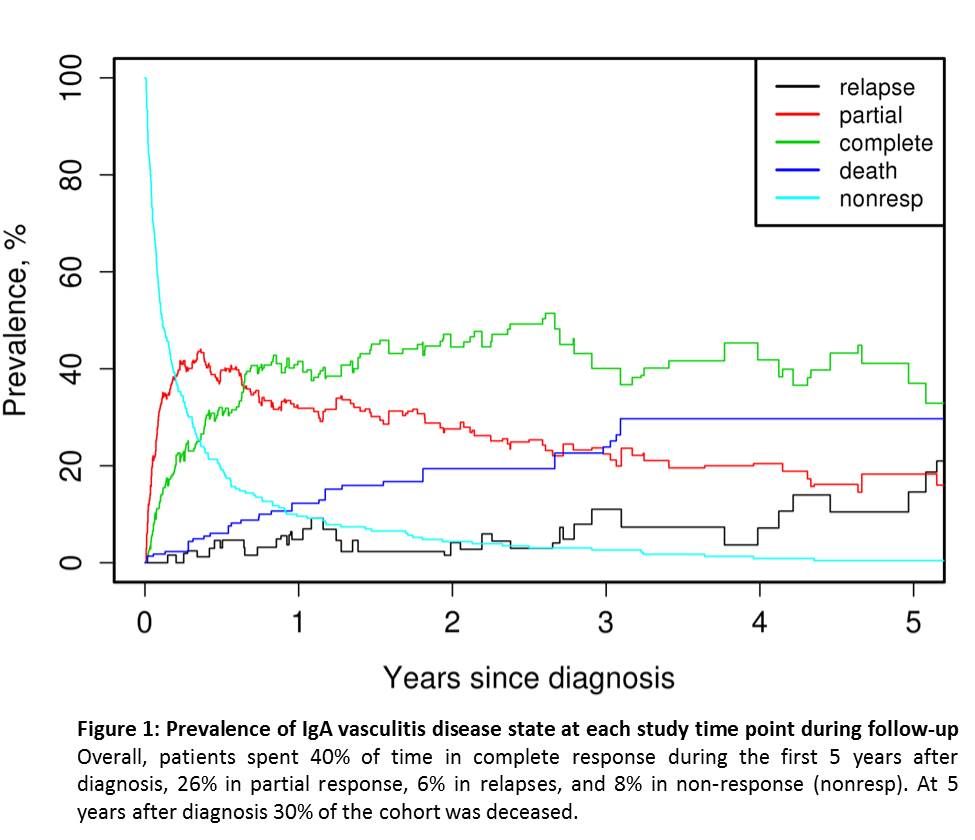Session Information
Date: Sunday, October 21, 2018
Title: Vasculitis Poster I: Non-ANCA-Associated and Related Disorders
Session Type: ACR Poster Session A
Session Time: 9:00AM-11:00AM
Background/Purpose: Differences in both presentation and outcome based on age of diagnosis have been described in patients with IgA vasculitis (IgAV) but data are limited due to cohort size and follow-up duration. The aim of this study was to describe the clinical characteristics and outcome of a large single-institution cohort of biopsy-proven IgAV.
Methods: Patients with biopsy-proven IgAV from 1997 to 2016 were retrospectively identified. Clinical characteristics, laboratory parameters and outcomes were abstracted from direct medical chart review. Proteinuria was classified as non-nephrotic (≥0.2 g/d, ≤3.5 g/d) or nephrotic (>3.5 g/d). Microscopic hematuria was defined as ≥5 RBCs/hpf or ≥2+ on dipstick. Disease activity at each follow-up visit was categorized as complete response (normalization of all baseline abnormalities due to IgAV), partial response, non-response (lack of improvement of any abnormalities due to IgAV) or relapse (development of clinical signs of IgAV after a symptom-free period of at least one month). Prevalence of disease activity was estimated using multi-state models, which account for competing risks.
Results: A total of 243 IgAV patients were identified (97% Caucasian, 58% male). 174 patients were adults (>21 years) and 69 were <21 years. ACR criteria were met in 98% of adults and 100% of patients <21 years. Compared to patients <21 years, adults at baseline had more frequent ulcerative skin lesions (11% vs. 1%; p=0.02) and nephrotic-range proteinuria (22% vs. 3%; p=0.007) but less commonly had abdominal pain (34% vs. 61%; p<0.001), ischemic gastrointestinal involvement (10% vs. 20%; p=0.04) and arthralgias (38% vs. 61%; p<0.001). Frequency of baseline microscopic hematuria was similar between groups (47%). 8 adults, but no patients <21 years, presented with end-stage renal disease. Oral (80%) and topical (23%) corticosteroids were the most common initial treatments used. Conventional immunosuppressive drugs were used at diagnosis in only 12% of patients.
Dialysis was required in 13 patients (8 adults) and renal transplant was performed in 4 cases (1 adult). Of 137 patients with hematuria during the study, 72% had complete resolution of hematuria by 1 year after onset, compared to 50% of 179 patients with proteinuria. The prevalence of disease activity state at each follow-up time point is shown in figure 1. During 389 person-years of follow-up, 29 deaths were observed. Five year survival rates (95% CI) for patients aged <21, 21-50, and 51+ years were 100%, 94% (87, 100) and 40% (26, 63), respectively (p<0.001). Standardized mortality ratio for patients aged 21-50 years at diagnosis was 5.62 (0.68, 20.3) and 7.60 (5.0, 11.1) for those 51 or older.
Conclusion: IgAV in adults is associated with more severe skin and kidney involvement, poorer renal outcome and increased mortality compared to patients diagnosed before 21 years of age.
To cite this abstract in AMA style:
Villatoro-Villar M, Crowson CS, Warrington KJ, Makol A, Ytterberg SR, Koster MJ. Clinical Characteristics of IgA Vasculitis in Children and Adults: A Retrospective Cohort Study [abstract]. Arthritis Rheumatol. 2018; 70 (suppl 9). https://acrabstracts.org/abstract/clinical-characteristics-of-iga-vasculitis-in-children-and-adults-a-retrospective-cohort-study/. Accessed .« Back to 2018 ACR/ARHP Annual Meeting
ACR Meeting Abstracts - https://acrabstracts.org/abstract/clinical-characteristics-of-iga-vasculitis-in-children-and-adults-a-retrospective-cohort-study/

